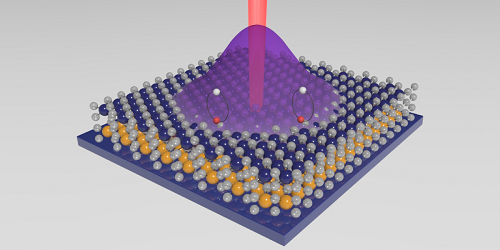Exciton Ensembles Manifest Coherence
Excitons are particle-like entities that form when electrons bind to electron vacancies called holes. A long-standing goal in condensed-matter physics is the unambiguous creation of a collective quantum state of excitons, known as a Bose-Einstein condensate, in a two-dimensional (2D) material; such a state could be used to study quantum effects and might find applications in quantum technology. A crucial step toward this goal is the observation that an ensemble of excitons in a 2D-material system can emit light in a spatially coherent manner. This feat has now been achieved by Alexander Holleitner at the Technical University of Munich and his colleagues [1].
The researchers investigated a stacked structure of two 2D semiconducting materials: MoSe2 and WSe2. In response to a laser pulse, electrons in the MoSe2 layer formed excitons with holes in the WSe2 layer. Then, after less than a microsecond, the electron and hole in each exciton combined to produce light. The team analyzed this light using an optical technique dubbed point-inversion Michelson-Morley interferometry. The results clearly showed that the excitons emitted light coherently.
Holleitner and colleagues found that, below 10 K, the spatial coherence length matched the size of the exciton ensemble and the temporal coherence time was several hundreds of femtoseconds. As they raised the temperature above 10 K, both these quantities decreased, suggesting that thermal processes were starting to counteract the exciton interactions. The researchers suggest that proving the creation of a Bose-Einstein condensate of excitons will require studies at temperatures much lower than 1 K.
–Ryan Wilkinson
Ryan Wilkinson is a Corresponding Editor for Physics Magazine based in Durham, UK.
References
- M. Troue et al., “Extended spatial coherence of interlayer excitons in MoSe2/WSe2 heterobilayers,” Phys. Rev. Lett. 131, 036902 (2023).




